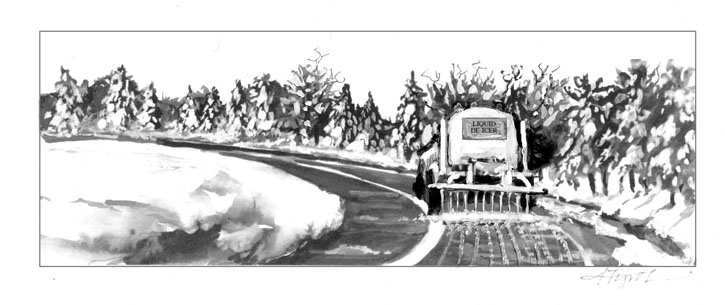By Kristen Fountain
All of a sudden, sap season is here and winter’s on its way out. Chances are, though, a few more snow or ice squalls are still to come. The next time you find yourself driving behind a big plow truck, take a look at what’s coming out of the spreader. What is used makes a difference for wildlife, especially as the snow melts.
Since the 1940s, rock salt, and lots of it, has been a boon to Northeast drivers. As a tool, it is simple and effective. The crystals are dropped evenly along the road, mixing into the slush over time by the weight of passing vehicles. The slush melts away because the combination of salt and water freezes at a lower temperature than water does alone.
However, the traditional approach of spreading dry rock salt is remarkably wasteful. Studies show that 30 to 40 percent of dry rock salt spread bounces and scatters off the road into the grass or nearby woods. This is bad for transportation budgets, and it’s also harmful to the environment. Most immediately, it’s a hazard for birds, who will die if they ingest too much of it, and to other wildlife which it attracts to busy roads.
As the salt dissolves into meltwater and breaks down into sodium and chloride ions, it causes other problems. In high concentrations, the chloride can brown leaves and needles, sometimes killing trees and shrubs near the roadways. It can also end up deep in the ground, sometimes ruining the taste of well water. But its largest effects are not ones you can immediately see or taste. When the salt reaches our lakes and rivers, it changes the water chemistry.
The concentration of chloride ions in waterways has gone up steadily over the past seven decades in Vermont and New Hampshire, as in other northern states where rock salt is used. Scientists now regularly find readings between three and ten times what they were in the early 20th century. Amounts much higher than that, by a factor of 100 or 1,000, have been found in small ponds and streams downstream from large highways and parking lots. At these higher levels, chloride can kill aquatic insects and even fish.
Concern over the salt build-up in our region’s waterways came into focus roughly in the mid-2000s, when water testing showed high salt levels in smaller water bodies around Interstate 93 in New Hampshire and in Vermont’s Chittenden County.
In response to these concerns, as well as the rising cost of rock salt (around $60 to $80 per ton over just the past two years), state transportation agencies have been making the switch to a salt brine slurry. Wetting the rock salt with brine eliminates salt clumps and makes the salt stick immediately to the road. That increases melting efficiency and reduces the amount of salt needed to clear our roads.
“It works to our benefit on multiple levels, environmentally and budgetarily,” explained Todd Law, head maintenance engineer for the operations section of the Vermont Agency of Transportation.
Every work district in Vermont except the Northeast Kingdom now “pre-wets” the salt it applies to paved roads with brine inside the spreader, just before it is released, Law said. He expects by next winter that last district will also transfer over.
In New Hampshire, in addition to using the brine-salt slurry, plows spread brine alone just before a storm to prevent ice from forming. However, the shift toward using brine has occurred largely only in the southern half of the state, said Eric Williams, supervisor of the watershed assistance section of the New Hampshire Department of Environmental Services, which helped the transportation agency facilitate the change. The southeastern corner especially is where there is a greater density of pavement and where water testing shows that brooks and ponds have been most affected, he said.
The switch from dry rock salt to brine is not, of course, a perfect environmental solution. However, Williams believes that New Hampshire DOT’s use of brine, along with better training for drivers and district managers, has pushed the agency’s overall winter salt use down by at least 20 percent from what it otherwise would have been. To estimate that figure, the agency uses a computer model, which takes into account the severity of a given winter. Vermont hasn’t yet tried to calculate a similar figure.
Attention is now turning to other players for further reductions is salt use. Town public works crews and private contractors are responsible for around half of each state’s paved roads, as well as for almost all parking lots.
Today both states’ transportation agencies sponsor training sessions for municipalities and private contractors, demonstrating how to incorporate brine and other methods for increasing efficiency. A two-year-old program in New Hampshire offers liability protection for private contractors who earn a “Green Snow Pro” certification. Around 350 operators have completed the course.
Kristen Fountain is a freelance writer living in Vermont’s Northeast Kingdom. The illustration for this column was drawn by Adelaide Tyrol. The Outside Story is assigned and edited by Northern Woodlands magazine and sponsored by the Wellborn Ecology Fund of New Hampshire Charitable Foundation: [email protected].




